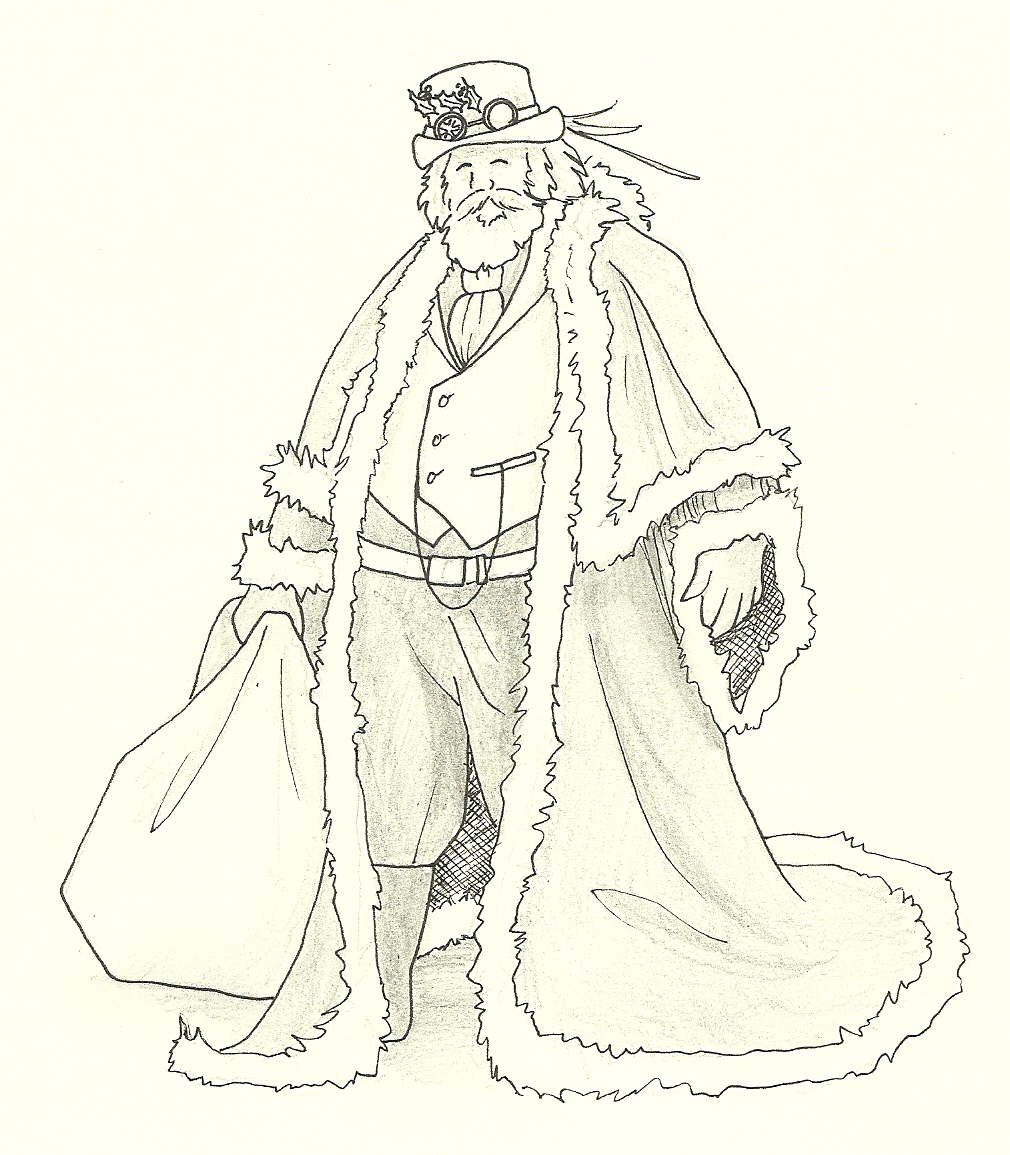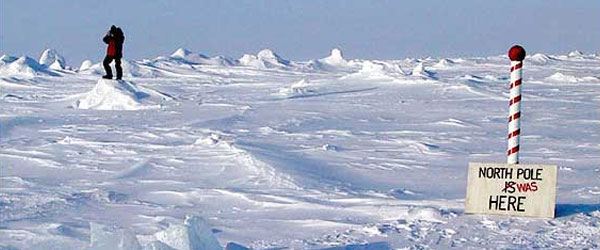Santa Part 2: The Village And The Old Man

As I stated in Part 1, my goal is to explain, or try to anyway, how Santa Claus could exist in the real world. This is no easy challenge. It will require a lot of speculation on top of actual science. But if Santa was easily explainable, he wouldn’t be a fantasy character. So now I take on the unbelievably ridiculous task of breaking down the characteristics of Saint Nick in the realm of science. I might need therapy after this series is done.
[Featured image: Andrew C. Revkin/The New York Times]
The North Pole Compound

The first issue is Santa’s village at the North Pole. It is said that there is a large town of houses and buildings in a rather quaint Middle Ages thatched-roof style where a plethora of little elves live and work, making toys. There is supposedly also the stables where Santa’s reindeer team is kept and a special residence for Santa and Mrs. Claus. (Strangely, the wife’s name is never stated. Perhaps “Misses” is actually her real name?) There are supposedly a lot of primitive workshops where the elves make various toys, sweet treats, and hot cocoa. There are a lot of different interpretations about the details of the Kringle campus, in literature, Hollywood, and popular culture.

There are a couple of problems with this. First of all, which North Pole? There are three. The most common thought that arises when mentioning the North Pole is the Earth’s axis. This is the northernmost point that stays in one place while the rest of the planet spins around it. Next is the Vertical North Pole. Earth is not straight up-and-down relative to the plant of the solar system. Seasons are the result of the 22.5 degree tilt. But this means that the Vertical North is constantly changing as the planet rotates. Finally is the Magnetic North Pole. It doesn’t always like to stay perfectly stationary, but is more than constant enough to be useful. The Magnetic North Pole is where magnetic compasses point to. Perhaps Santa’s Village is the cause of said magnetism?
Not so fast. Above the Arctic Circle is primarily a desolate and icy wasteland amid the Arctic Ocean. So far, no happy little village has been located. Could it be under the ice as so many movies have suggested? Not exactly. The ice isn’t that thick. And just under that ice is nothing but ocean. So unless the cute little houses double as perpetually-sustaining submarines, under the ice is not a very good place to put a village. So could there be some sort of invisibility cloak around the city? Not likely. Someone exploring the Pole would likely have bumped into it at some point. So how could the North Pole Village stay hidden? Let’s look at three possibilities.
1. Phased Out
Here’s something which has been mentioned in a lot of sci-fi including such things as Star Trek. There is the idea that the particles that make up the matter of the North Pole Complex vibrate at a slightly different frequency as the rest of the matter in the world. So in a sense, it’s almost as if it’s in its own dimension. Then when Santa departs to deliver packages to the world, the vibrational frequency realigns with everything else and becomes tangible in the “real world”. As long as it’s phased out, the compound will not be visible or tangible to those who travel to the area.
2. The North Pole Gateway
Secondly, let’s look at the possibility that the compound is not actually at the North Pole. However, there is a hidden gateway at the North Pole if you know where to find it and how to approach it. It would, in effect, be less like a Stargate and more like running into a train station pillar to get to Hogwarts. This would be done by way of a wormhole. Wormholes are still theoretical, but most physicists seem to have adopted the idea as a reality. If wormholes are a reality, then they are on the quantum level. Theoretically (a word we’re using a lot in this series), enough energy could be expended to enlarging a wormhole and keep it open long enough for someone or something to pass through. Wormholes take advantage of curved space-time to connect two points in a shorter distance. It is, basically, a shortcut between two points brought closer through the curvature of space.
3. Ha, Made You Look!
Finally, there is another take on the idea that the North Pole Complex is not really at the North Pole. The very notion that there is anything at the North Pole is a misdirection that gets everyone looking in the wrong place. (Those sneaky elves … ) Then they can do that funky thing they do without anyone interfering in their operations.
Forever Young

Now it’s time to address that whole longevity thing. How can an old man do this year after a year for centuries? That’s something that’s certainly not easy to accomplish. The longest lifespan recorded in modern times is only slightly over 120 years. That makes Santa’s eternal youth something Dick Clark couldn’t even dream of. In order to accomplish this, there are some rather sizable obstacles to overcome.
The first obstacle is toxic buildup in the cells of the body. The human body never can seem to completely flush out toxins. Scarring after a wound is one example. If all the toxins could be flushed out, there would be no permanent scarring. Eating poorly also contributes to toxic aging. The fact that Santa smokes a pipe doesn’t help him much in this regard.
Not only is an excess of toxins a problem, so is a deficiency in various proteins and nutrients. In many cases, this can be just as harmful, if not more so, than toxic poisoning. Insufficient diets are a widespread problem, and not just among those in need. So remember to take your vitamins, kids.
Then there is gradual and progressive cellular and genetic damage. Human cells are extremely complex systems. High school biology textbooks ton’t do justice to the complexity. The greater the complexity of any system, the greater the chance for failure. Biological organisms are constantly producing more cells, mainly in order to replace the dying ones. Unfortunately, as if the older cells having a tendency to linger weren’t enough, damaged cells also replicate themselves through mitosis. The depletion of telomeres on chromosomes are one of the most prominent examples of ongoing degradation.
So how can someone like Santa continue on for so long?
1. Stasis
One possibility is that Saint Nicholas is held in stasis of some sort that keeps his body from degrading throughout the year. He would be brought out of stasis for two weeks out of the year, one for preparation and execution, and the other for vacation. If this were the case, then 200 years of Christmases would amount to about 4 years to the jolly fat man. As for what kind of stasis, I have no clue. But we can probably rule out cryostasis (deep freezing). Human cells contain large percentages of water. Water expands when it freezes. The cells burst. There has been recent research with mice where the blood is replaced by a completely different fluid which can withstand freezing. But in the end, it’s still impractical and unproven.
2. Nanotechnology

Perhaps Santa has tiny robots in his blood stream which clean out toxins and repair cellular damage. They could be self-replicating and self-replacing. They could also provide certain enhancements. In other words, maybe Santa’s a Borg.
3. Replacement Santas
Option number three is to have a different Santa every year. It’s hard telling where all these Santas are coming from. Maybe there’s a massive worldwide recruiting drive or something of the sort. I guess it could also be by cloning, but there are a lot of issues with cloning. But maybe there’s another similar option …
4. Quantum Entanglement
In quantum mechanics, there is an offshoot of the Heisenberg Uncertainty Principle called Quantum Entanglement. This is when two particles, regardless of the distance between them, can become “entangled” and take on the exact same characteristics. When enough particles become entangled before separating, you get something that is exactly like the original. It’s also a proven theory. Researchers have recently gotten up to three atoms, and have managed to do the same thing with electrons for possible use in communication. As long as you have the quantum patterns and behaviors for Santa saved in computer memory, one can create a new Santa every year. One would just hope they can get each one to live. Just because everything is intact doesn’t mean it functions. Ask any mortician.
So there is a possibility of an eternal Santa, no matter how creepy and disturbing he might be. But as long as the good little boys and girls don’t know how he got there, they will still leave out the milk and cookies.
![]()




